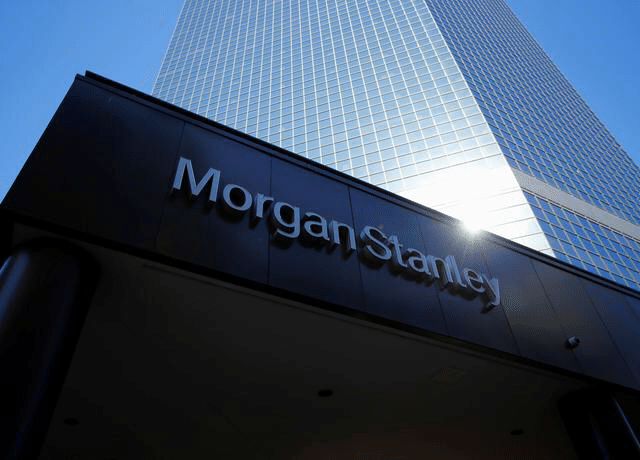
Morgan Stanley profit plunges, warns of more pain ahead≒モルガン・スタンレーの利益が急落、今後のさらなる痛みを警告 https://www.reuters.com/article/us-morgan-stanley-results-idUSKCN21Y1L7
Morgan Stanley profit plunges, warns of more pain ahead≒モルガン・スタンレーの利益が急落、今後のさらなる痛みを警告
https://www.reuters.com/article/us-morgan-stanley-results-idUSKCN21Y1L7
(Reuters) - Morgan Stanley (MS.N) Chief Executive Officer James Gorman warned that the bank would take "longer to achieve" its medium-term financial targets due to the coronavirus crisis, after its first-quarter profit slumped by 30%.
In January, just before the virus started spreading around the world, Gorman boosted the bank's performance targets and set new goals for cost-cutting, returns on equity and wealth management profits over the next two years and beyond.
In the weeks that followed, the pandemic forced sweeping lockdowns, shuttered businesses, left millions jobless and raised fears of a severe recession, prompting Wall Street banks to set aside billions to cover for potential losses.
ADVERTISEMENT
Morgan Stanley said the current economic crisis will push its targets out of its reach and a long-drawn-out crisis could adversely affect its business in the coming quarters.
"As long as the duration and scale of the pandemic and economic slowdown remain uncertain, I expect markets will continue to be fragile. The resulting stress on the global economy is real and will take time to recover," Gorman said on a call.
The bank's results capped a tumultuous quarter of earnings reports from big U.S. lenders, which reported sharp declines in profit and boosted their reserves in anticipation of a wave of loan defaults and non-payment of credit card bills.
Morgan Stanley reported a below-target return on tangible common equity (ROTCE) in the first quarter, and Gorman cautioned that the bank probably will not meet them in the next quarter.
RELATED COVERAGE
VIDEO Morgan Stanley profits plunge, with more pain ahead
"It would be irresponsible of me to recommit to those targets on this call. Those targets are not achievable in the second quarter, they weren't achievable in the first quarter," said Gorman, who recently recovered from the illness caused by the novel coronavirus.
Morgan Stanley differs from most of the other big six U.S. banks because it does not have large book of consumer loans and credit card business like JPMorgan Chase (JPM.N), or significant balance sheet investments like those of rival Goldman Sachs (GS.N).
ADVERTISEMENT
That business mix appeared to work in its favor, as it did not have to set aside massive loan loss provisions.
Its robust performance in trading mirrored a similar showing from bigger rivals Goldman Sachs (GS.N) and JPMorgan (JPM.N), both of which clocked double-digit growth in equities and bond trading.
Photo
FILE PHOTO: The corporate logo of financial firm Morgan Stanley is pictured on a building in San Diego, California, Sept. 24, 2013.
REUTERS/MIKE BLAKE
Trading revenue at Morgan Stanley surged 30%, boosted by wild swings in markets. This was led by a 29% jump in bond trading and a 20% rise in equities trading.
However, revenue at Morgan Stanley's wealth management unit, which contributes roughly half to its total revenue, fell 8% to $4.04 billion, as it bore the brunt of the ongoing turmoil in financial markets.
Advisory revenue fell 11% as dealmaking took a beating in the quarter, with businesses bracing for a massive slowdown in the coming months.
Morgan Stanley's $13-billion deal to buy discount brokerage E*Trade Financial Corp also coincided with the spread of the coronavirus, forcing management to justify the buyout to investors. The company said it was on track to close the deal in the fourth quarter.
ADVERTISEMENT
Investment management revenue at Morgan Stanley fell 14% to $692 million, hurt by valuation mark-downs on its investment portfolio and lower interest on loans.
The bank said earnings attributable to common shareholders fell to $1.59 billion, or $1.01 per share, in the first quarter ended March 31. Analysts had $1.14 per share, according to IBES data from Refinitiv.
(Reporting by Bharath Manjesh and Noor Zainab Hussain in Bengaluru and Elizabeth Dilts Marshall and Matt Scuffham in New York; Writing by Anirban Sen; Editing by Saumyadeb Chakrabarty)
Our standards: The Thomson Reuters Trust Principles.
(ロイター通信)-モーガンスタンレー(MS.N)のCEO、ジェームズゴーマン氏は、第1四半期の利益が30%減少した後、コロナウイルスの危機により、銀行は中期的な財務目標を「より長く達成する」必要があると警告しました。
ウイルスが世界中に広がり始める直前の1月に、Gormanは銀行の業績目標を引き上げ、今後2年間およびそれ以降のコスト削減、資本利益率、ウェルスマネジメント利益の新しい目標を設定しました。
その後の数週間で、パンデミックにより強制的な封鎖が行われ、企業が閉鎖され、数百万人が失業し、深刻な景気後退の恐れが高まり、ウォール街の銀行は潜在的な損失を補うために数十億ドルを確保するようになりました。
モルガン・スタンレーは、現在の経済危機はその目標を手の届かないところに押し出し、長期に及ぶ危機は今後の四半期の事業に悪影響を与える可能性があると述べた。
「パンデミックと経済減速の期間と規模が不確実である限り、私は市場が脆弱であり続けることを期待しています。その結果としての世界経済へのストレスは現実であり、回復するのに時間がかかります」とゴーマンは電話で言った。
銀行の結果は、米国の大手貸し手からの騒然とした四半期の収益報告を覆い、それは利益の急激な減少を報告し、ローンデフォルトの波とクレジットカード請求書の不払いを見越して彼らの準備を押し上げました。
モルガン・スタンレーは第1四半期に目標を下回る有形普通株主資本利益率(ROTCE)を報告し、ゴーマンはおそらく銀行が次の四半期にそれらを満たさないと警告した。
関連カバレッジ
ビデオモルガンスタンレーの利益は急落
「これらの目標をこの電話で再度コミットすることは私には無責任です。これらの目標は第2四半期には達成できません。それらは第1四半期には達成できませんでした」と小説によって引き起こされた病気から最近回復したGormanは言いました コロナウイルス。
モーガンスタンレーは、JPMorgan Chase(JPM.N)のような消費者ローンやクレジットカードビジネスの大規模な本、またはライバルのゴールドマンサックス(GS.N)のような重要なバランスシート投資がないため、他のほとんどの米国の6大銀行とは異なります。 )。
大規模な貸倒損失引当金を確保する必要がなかったため、そのビジネス構成は好意的に機能しているように見えました。
取引における堅調なパフォーマンスは、より大きなライバルであるゴールドマンサックス(GS.N)とJPMorgan(JPM.N)の同様の結果を反映しており、どちらも株式と債券の取引で2桁の成長を記録しました。

ファイルの写真:金融会社モルガンスタンレーの企業ロゴは、2013年9月24日、カリフォルニア州サンディエゴにある建物に描かれています。
ロイター/マイク・ブレイク
モーガンスタンレーのトレーディング収益は、市場の急激な変動に後押しされて30%急増しました。 これは、債券取引の29%の上昇と株式取引の20%の上昇に牽引されました。
しかし、モルガンスタンレーのウェルスマネジメントユニットの収益は、その総収益の約半分を占めており、金融市場で進行中の混乱の先駆けとなったため、8%減少して40億4000万ドルになりました。
商談が今四半期に大打撃を受け、企業は今後数か月の大幅な減速に歯止めをかけたため、アドバイザリー収益は11%減少しました。
モーガンスタンレーの割引ブローカーを購入する130億ドルの取引E * Trade Financial Corpもコロナウイルスの拡散と一致しており、経営陣は投資家への買収を正当化する必要がありました。 同社は第4四半期に取引を完了する予定であると語った。
モルガンスタンレーの投資運用収益は14%減少し、6億9,200万ドルとなりました。これは、投資ポートフォリオの評価値下げとローン金利の低下により打撃を受けました。
銀行によると、3月31日までの第1四半期には、普通株主に帰属する利益は15億9,000万ドル(1株あたり1.01ドル)に減少しました。RefinitivのIBESデータによると、アナリストは1株あたり1.14ドルでした。
(バンガロールのBharath ManjeshとNoor Zainab Hussain、ニューヨークのElizabeth Dilts MarshallとMatt Scuffhamによるレポート、Anirban Senによる執筆、Saumyadeb Chakrabartyによる編集)
当社の基準:Thomson Reuters Trust Principles。
この記事が気に入ったらサポートをしてみませんか?
